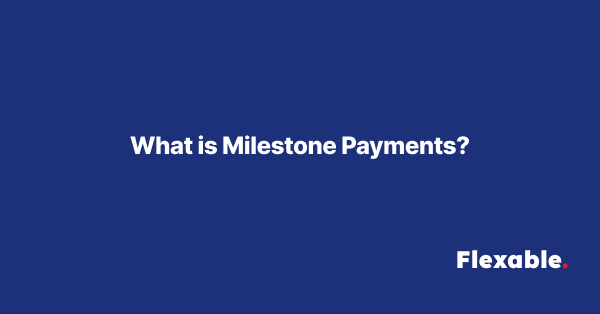In the world of freelancing, trust and transparency are key to building successful client-freelancer relationships. This is where milestone payments come into play. Milestone payments are a payment structure designed to create clarity, security, and accountability for both clients and freelancers during project collaborations.
By dividing a project into smaller, manageable segments, known as milestones, and tying payments to the successful completion of each milestone, this approach ensures that work progresses smoothly and that all parties are satisfied at every stage of the process. In this article, we’ll explore the concept of milestone payments, how they work, and their benefits for both clients and freelancers.

Understanding Milestone Payments
Definition:
Milestone payments are partial payments made at predefined stages of a project. Instead of paying the freelancer the full amount upfront or upon project completion, the client releases payments incrementally after specific milestones are completed and approved.
How They Work:
Defining the Milestones:
At the start of the project, the client and freelancer agree on the project scope and divide it into logical milestones.
Each milestone represents a significant deliverable or phase of the project (e.g., a completed design draft, a first batch of written content, or a beta version of a software application).
Setting Payment Amounts:
The total project fee is divided across the milestones. The payment for each milestone is typically proportional to the amount of work or effort required for that phase.
Payment Release:
When a milestone is completed, the freelancer submits the deliverable for client review.
Once the client approves the milestone, the payment for that milestone is released, usually via the freelancing platform or an agreed-upon payment method.
Benefits of Milestone Payments
Milestone payments offer numerous advantages for both clients and freelancers, ensuring fair compensation and fostering collaboration.
For Clients:
Risk Management:
Clients avoid paying the full project cost upfront, reducing financial risks.
If the project is terminated or the deliverables fail to meet expectations, payments stop at the last approved milestone.
Quality Assurance:
Clients can evaluate the quality of work at each stage, ensuring the final deliverables align with their expectations.
Feedback can be provided at every milestone, enabling adjustments and corrections before proceeding to the next phase.
Budget Control:
Payments are spread out over time, making it easier to manage budgets for larger projects.
For Freelancers:
Guaranteed Payment:
With platforms offering escrow services, freelancers are assured that funds for a milestone are secured and will be released upon approval.
Motivation and Accountability:
Milestone payments create a structured workflow, allowing freelancers to focus on achieving clear, measurable goals.
Reduced Payment Delays:
Instead of waiting until the end of a project to get paid, freelancers receive payments throughout the process, improving cash flow.
Examples of Milestone Payments in Action
Scenario 1: Website Development Project
A client hires a freelance web developer to create a website for $3,000. The project is divided into three milestones:
Milestone 1 ($1,000): Initial website design and wireframes.
Milestone 2 ($1,000): Development of the website’s front-end and back-end functionality.
Milestone 3 ($1,000): Final testing, debugging, and deployment of the website.
After each phase is completed and approved, the freelancer receives payment for the respective milestone, ensuring progress and satisfaction on both sides.
Scenario 2: Content Writing Project
A client hires a freelance writer for a series of blog posts worth $500. The project is divided into milestones:
Milestone 1 ($250): Delivery of the first 5 blog posts.
Milestone 2 ($250): Delivery of the remaining 5 blog posts.
The client releases payment after reviewing and approving each batch of content.
When to Use Milestone Payments
Milestone payments are particularly useful for:
Large or Complex Projects: Projects with multiple phases, such as app development or marketing campaigns, benefit from milestones to ensure progress.
New Client-Freelancer Relationships: For first-time collaborations, milestones build trust and confidence between parties.
Projects with Iterative Feedback: Milestones allow for adjustments and refinements based on client input, improving the final outcome.
Milestone Payments on Freelancing Platforms
Freelancing platforms like Upwork, Fiverr, and Freelancer.com offer built-in milestone payment systems. These platforms use escrow services to secure funds, ensuring a smooth and secure transaction for both parties.
How Escrow Works:
The client funds the milestone amount into escrow before work begins.
The freelancer starts working, knowing that the funds are secured.
Upon milestone completion, the client approves the work, and the payment is released to the freelancer.
This system protects both parties by ensuring that clients pay only for completed work and freelancers are compensated for their efforts.
Tips for Using Milestone Payments Effectively
Set Clear Deliverables: Define specific, measurable goals for each milestone to avoid misunderstandings.
Communicate Regularly: Maintain open communication to provide feedback and address concerns at each stage.
Agree on Terms: Both parties should agree on the number of milestones, payment amounts, and timelines before starting the project.
Use Escrow Services: For added security, use platforms or tools that hold milestone funds in escrow.
Conclusion
Milestone payments are a powerful tool for fostering trust, ensuring accountability, and managing project risks in freelancing. By dividing projects into smaller, achievable phases, this payment method benefits both clients and freelancers, creating a win-win scenario for successful collaborations.
Whether you’re a freelancer looking for consistent payment or a client seeking quality assurance, adopting milestone payments can streamline workflows and lead to better outcomes for all involved.

